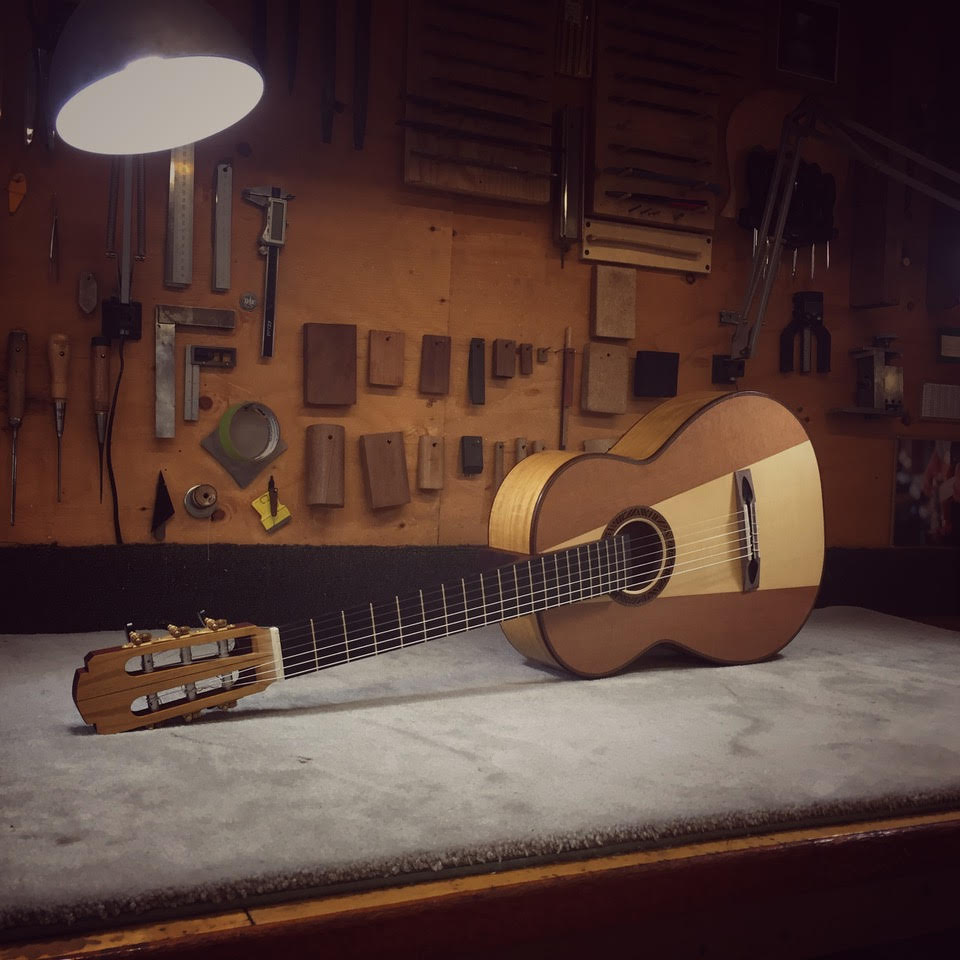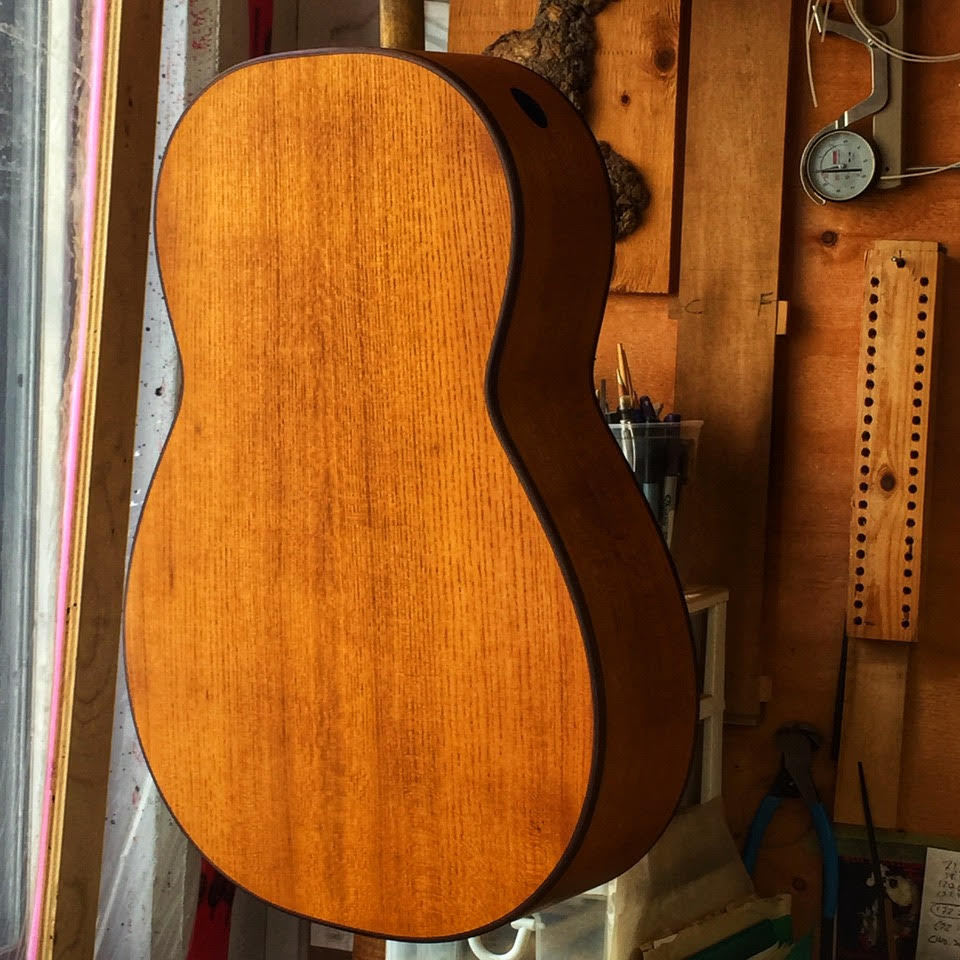“In the place of worn earth we walk on its softness…”- Linda Hogan

I had the enormous pleasure of visiting the workshop of Montreal luthier Jeremy Clark recently. As we entered the cloakroom he pointed to his bare feet saying that everyone in the coop [10 in all] worked that way. My friend and I removed our boots and walked into the workspace in our stocking feet. After the entry hall was a machinery room with a couple of big band saws and drills all hooked up to industrial vacuums – no sawdust on the socks yet!
 Then we enter into the workspace where five workstations are set up along each of two walls ending at a large window. They are equally spaced, well organized and tidy. Jeremy’s is next to the window and we stand around chatting as he makes coffee from freshly roasted Ethiopian beans.Jeremy is affable, full of joy and passion for his craft. After an appropriate chat, he moves to open a guitar case. “Osage Orange,” he says, turning the back and sides so we can appreciate the colour. “Osgae Orange is actually not all that common of a tone wood. It’s a tree that’s original native to the the Red River drainage of (what is now) Oklahoma, Texas, and Arkansas. Sometimes referred to as “bois d’arc” from early French settlers who saw how valued it was to Native Americans for the purpose of bow construction. Despite it’s name “Osage Orange” is only distantly related to the orange fruit and it’s actually in the Mulberry family. From a material properties and acoustic perspective it’s about as close to Brazilian as any wood you’ll find. The tree that we harvested was actually just oustide of Cookeville Tennessee. Cut it down myself in Georgia. Top is high altitude Russian Spruce.” It is a few years old, and has a 640 – 650 mm fan-fretted string length . As I start to play I note the easy action and the Pau Ferro fretboard. I touch it more carefully, noting the silky softness. “Polished” I ask?I
Then we enter into the workspace where five workstations are set up along each of two walls ending at a large window. They are equally spaced, well organized and tidy. Jeremy’s is next to the window and we stand around chatting as he makes coffee from freshly roasted Ethiopian beans.Jeremy is affable, full of joy and passion for his craft. After an appropriate chat, he moves to open a guitar case. “Osage Orange,” he says, turning the back and sides so we can appreciate the colour. “Osgae Orange is actually not all that common of a tone wood. It’s a tree that’s original native to the the Red River drainage of (what is now) Oklahoma, Texas, and Arkansas. Sometimes referred to as “bois d’arc” from early French settlers who saw how valued it was to Native Americans for the purpose of bow construction. Despite it’s name “Osage Orange” is only distantly related to the orange fruit and it’s actually in the Mulberry family. From a material properties and acoustic perspective it’s about as close to Brazilian as any wood you’ll find. The tree that we harvested was actually just oustide of Cookeville Tennessee. Cut it down myself in Georgia. Top is high altitude Russian Spruce.” It is a few years old, and has a 640 – 650 mm fan-fretted string length . As I start to play I note the easy action and the Pau Ferro fretboard. I touch it more carefully, noting the silky softness. “Polished” I ask?I
“A bit,” he mutters and I chuckle, suggesting that his comment is somewhat understated. I have never felt a fingerboard so smooth, and know from past encounters that Jeremy can be proneto impish understatement at times. The radius of the fretboard and the raised fingerboard combine to make it very easy to play. The sound is sweet, but after a few minutes I try to bring out the upper overtones by playing about an inch from the saddle with as much volume as I can muster. “Pumping out the highs,” I say – to which Jeremy responds, “Hasn’t been played much.”

orange osage tree
As if prompted by an unseen stage manager, Jeremy moves to open another case. This is the spruce/cedar hybrid Patrick Kearney wrote about recently. It is a standard fretted instrument with a sting length of 650. Like the Osage orange guitar, this has the thick heavy sides that are one of Jeremy’s idiosyncratic design features. I find this instrument to be highly responsive to my left hand, and I seem to put vibrato on every note. The easy action seems to inspire this. Dynamics come out well, and the instrument responds in an uncanny manner to my every change of weight, articulation or expressive gesture. As I play, different sounds highlight themselves: at one point it is the ‘C’ on the third string that wants to be heard, and soon after an ‘F’ at the 15th fret on the fourth string asserts itself. Again I find the sound about too sweet and once again pound out the ponticello. I look at Jeremy who says, “Hasn’t been played much.”
The sides and back on this instrument are Ceylon Satinwood. “Ceylon Satinwood has all the acoustic potential of the best rosewoods and was the wood used on the finest French furniture in the 17th Century. Because of the high regard in which it was held historical makers such as Enrique Garcia, and Francisco Simplicio used it on their “fanciest” exhibition pieces.”

We start talking about double tops and Jeremy brings down an instrument that hasn’t been played at all. The tuners aren’t don’t even have screws to attach them to the head stock, they are only temporary ones until the good ones come in. This instrument is high altitude Russian spruce on the outside with American red cedar on the other side of the nomex sandwich. Standard frets, 650mm string length with back and sides made from Wenge. “Wenge generally comes from the swampy areas of Cameroon and was used traditionally for ceremonial masks and statues. It’s quite stiff, low damping, and with a high velocity of sound…in short it’s great for backs/sides.” The clear round sound is like the high alpine spruce sound I am looking for. Every once in a while I look to Jeremy, who by now is getting a little exasperated, “William, its not finished yet,” he says to my unvoiced queries over and over.
 As I play there are intriguing sounds, a loud note on the fourth string then a quiet third string open, followed with a natural harmonic, for example. The special quality amuses me for several minutes before I move on to a set of dissonant clusters over quiet open strings.
As I play there are intriguing sounds, a loud note on the fourth string then a quiet third string open, followed with a natural harmonic, for example. The special quality amuses me for several minutes before I move on to a set of dissonant clusters over quiet open strings.
Laughing I say, “this is the last thing I expected to find here – classic European single top sound from a Jeremy Clark double-top.” Chuckling for a bit I add, “bet this wasn’t what you expected either!” He nods and explains that this instrument was kind of recycled – the top wasn’t good enough so it became a good way to try a double top experiment, since the neck and body was already built, he needed only to fit the newly conceived double top to the existing structure.
My friend moves ten metres back in order to ascertain the guitar’s projection. We compare the hybrid and the double top and my friend says that both are about equal at that distance. Jeremy explains that he strives to produce the same clarity in the middle four strings that are often evident on the outside ones. “In many concerts and competitions I sit at the back of the hall and can’t hear the middle notes very well. It seems a shame when so much work has went in to learning the repertoire that we should miss those notes.” My improvising changes to reflect these notions. If not quite as responsive as the hybrid guitar, this was still a very responsive guitar. Save for the fact that it was a 650mm string length I might have tried to bring it home with me.

Jeremy explained that you could adjust the action with an alan key, so I asked for a demonstration which he quickly gave, opining that players might want to use the lower action to save wear and tear on the body in the lead up to a concert or event.
All the instruments are very attractive, and with such intriguing design concepts it is fascinating to note that his sound ideal is almost conservative: to produce a beautiful and responsive instrument with good timbral variety and a wide range of dynamics.
Nasruddin’s sweetheart had finally agreed to marry him and a they were chatting in the grass by the river,
“I am so happy, my love,” said Nasruddin, “have you told your parents that I write poetry?”
“Not yet, my dear,” replied the girl, “but they know about your drinking and gambling. I thought it best not to tell them everything at once.”
https://soundcloud.com/william-beauvais/the-light-lies-on-the-lake
Enjoyed the walk through. In our part of the world, osage orange is a bit of a four-letter word. Planted as a windbreak along fields and pastures, it has self- propagated and voluntarily taken over. While the cattle and deer sometimes pick at the circular neon green orbs that fall from these trees, we struggle to find any true use to them. I’m glad you’re putting the wood to good use.
well the fellow travelled from montreal to harvest it – has used it in a couple of guitars, and has left some in the US stored for future use…